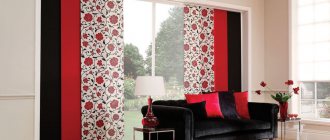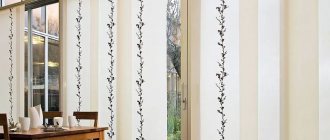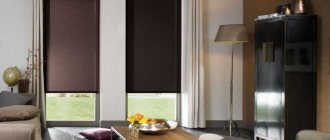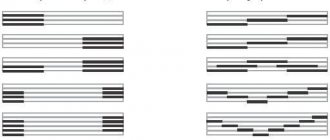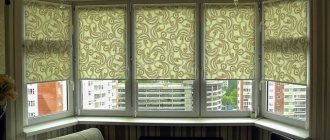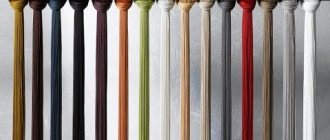Japanese curtains (in other words - panel curtains, screen curtains) are sliding structures, the appearance of which the world owes to the small-sized homes of the Japanese. They found a solution that fully corresponded to their mentality - laconic and elegant.
Initially, the panels were intended to divide a large space into small compartments, each with its own purpose. Hanging them on windows is a European idea.
Japanese curtains are straight panels of fabric up to 1.5 m wide, moving sideways along fixed guides (one or more) - similar to vertical blinds or wardrobe doors. Thin and light fabric is additionally stretched over the frame so that there are no folds; dense fabric is simply weighted from below. Cornices are attached to the ceiling, walls, floor, and doorway lintel.
Panel curtains never have folds, decorative cords, bows, fringes or other accessories.
In terms of versatility, little can compare with them - they are used to make window curtains, doors, walls and screens. By rearranging a couple of panels, you can achieve noticeable changes in the interior with a minimum of effort.
Advantages and disadvantages of Japanese curtains
In recent years, the popularity of Japanese-style curtains has been constantly increasing; they have a number of advantages:
- There is no need to limit your imagination in choosing the color and texture of the fabric.
- The products are easy to care for and cleaning will not take much time. Dirt practically does not cling to the panels.
- You don't need a professional to hang curtains. All work is considered simple; anyone can handle it.
- Japanese curtains consist of a small amount of materials. To create standard models, many times more fabric would be required, and the price of the finished product would be higher.
- The canvases are perfect for use in rooms where the bright sun often shines. The entire living space will be well protected from harsh and blinding rays. The lighting will still be natural, but more diffused and softer.
In order to hang the panels, you do not need to call a specialist.
The only significant drawback of curtains against the background of their advantages is the small choice in terms of shapes. Often you have to consider two options: square and rectangular.
The shape of curtains can be square or rectangular.
Mounting methods and options for cornices
Cornices can be attached to the ceiling, walls, or floor.
Tire
This cornice consists of several rows of tires. There may be a different number of them, but no more than 5. Panels are attached to each row. Depending on the design idea and preferences of the owner, screens can have different lengths, textures, and colors. Japanese curtains are attached at the top using Velcro tape, and a weighting material is placed at the bottom.
Tubular
Classic cornice for all interiors. It can be made of plastic, wood, metal. The panels are attached to the cornice using rings or fabric loops.
Selecting fabric type and color
To create classic curtains in the Japanese style, natural materials are used, and they are not necessarily fabric. The following materials are used in production: thick rice paper, jute, straw or bamboo plates. At first, curtains were produced in one tone, and did not play the role of decoration, only functionality was important.
In the modern world there are no restrictions in the choice of materials; everyone can find an option that will suit their unique home interior.
For those who strive for eclecticism, it is better to pay attention to fabrics with different textures and shades. Carefully ensure that the canvases fit well together.
You can combine fabrics of different textures and colors.
To ensure that the shape of the product is not lost over time, choose fabrics made from linen, silk, satin, cotton; these materials are dense and do not stretch. They can be interestingly combined with translucent moire or chiffon panels.
Curtains made of thick materials are more durable.
If the interior is made in a minimalist style, then it is better to choose a single-color canvas with a small pattern. Curtains with plant motifs are widely popular.
The plant motif is in wide demand.
Advice. In all other cases, the use of bright colors and catchy prints is allowed.
Materials for production
Textile design of curtains involves the use of a fairly diverse arsenal of materials. If for rooms such as the kitchen and children's room it makes sense to use cotton fabric (it is low-allergenic, environmentally friendly and durable when washing), then in the living room options such as
- Bamboo;
Bamboo curtains
- Reed fabrics;
- Rice paper.
- Rattan panels.
The panel curtains for the kitchen look original and are made of multi-colored plastic.
When composing an ensemble of several panels, they can be arranged symmetrically or asymmetrically, made by alternating light transparent and dense light-absorbing fabrics. In this case, Japanese curtains will perform the functions of curtains and curtains at the same time.
Japanese panels
The appearance and other characteristics of Japanese curtains are very different from the usual type of window decor. The screen panels have a special design: there is a holding element in the upper part, there is also a base and a weighting agent. There should be no difficulties in using the products. All components are wear-resistant and functional.
Japanese curtains are functional and easy to use.
Japanese panels have interesting features:
- the operating system is associated with blinds, the products may have sections, their number is related to the size of the window frame;
- the width of one sectional canvas can be more than 100 centimeters;
- curtains must be controlled using a special chain, cord or remote control;
- the panels move like a screen; this principle is considered modern and convenient.
The design of Japanese curtains has its own characteristics.
Each piece of Japanese paintings is a unique product that combines beautiful colors and new technologies.
Kitchen ideas
The main room in the house, according to many housewives, is, of course, the kitchen. It is here, and not in other, more formal rooms, that we spend most of our quiet family evenings. That is why curtains for the kitchen should not only be made from high-quality materials, but also have an excellent appearance that will appeal to all family members.
A good solution could be Japanese curtains for the kitchen with a simple and laconic design. If the window is large enough, then you can safely experiment with their length and colors.
According to psychologists, warm colors help increase appetite, so feel free to choose panels with red, yellow and orange patterns. In general, any of their design options look harmonious on such windows.
If the kitchen is small and the kitchen window is not large in size, then translucent curtains up to the window sill or lower in length, made of a light-colored material, would be a suitable choice. This will visually expand the window and give a feeling of plenty of space and air.
Japanese drawing
The images on Japanese curtains can be varied, most often the designs reflect the motives of the native state. At the market you can find products with cherry blossoms, hieroglyphs, dragons or Mount Fuji.
Several ornaments look great on the panels. The most discreet option would be curtains made in natural colors with geometric patterns. If the interior needs an expressive spot, choose curtains with bright and large patterns.
For a restrained interior, you can use geometric patterns.
Panel space is a canvas open to extraordinary ideas, but it is advisable not to use popular photo printing on fabric. The image should look natural, as if the work was done by hand. Traditional landscapes applied to canvas using ink or paint will look most appropriate on curtains.
For the living room
Combined variations are suitable for the hall. Japanese curtains can be combined with tulle; together they will fill the room with warmth and comfort. It is very important that in the living room every detail is in harmony with the other.
It is better to choose materials that will not deform in the future - natural, linen, cotton, silk and others. The hall welcomes curtains with bright prints and patterns. Will always be in trend: large flowers, stripes, birds, animals, nature. Don't forget about moderation.
Interior Japanese curtains
Doors are an integral part of many rooms. Japanese curtains can be used as interior partitions. The design according to the description will be almost the same as for window decoration: panels and cornices. The key difference is that the doors will be made of denser and harder material: cotton, bamboo, reed.
Japanese panels are often used as interior partitions.
The main advantage of such products is that such panels open conveniently, hiding behind each other, they do not take up much space. Japanese curtains will add lightness and transparency to the interior, replacing traditional interior models well.
Sliding panels add lightness to the room.
Doors usually use several panels; the height of the product can be from floor to ceiling. Cornices can be mounted at any level, it all depends on the preferences of the homeowner.
Rules of care
Keeping the curtain panels clean is no problem. Here it is necessary to remember the care of vertical blinds.
Before removing the blinds for washing, you need to straighten them and remove additional decorations and fastenings. Then, fold them several times, carefully immerse them in warm water with detergent.
Washing vertical blinds is a common hygienic procedure. You can pre-soak them in a product recommended for this material. However, the fabric of panel curtains often contains anti-dirt, anti-grease and anti-odor impregnation, as well as special threads that give it strength. Therefore, washing in a washing machine should be done on a gentle cycle. It is advisable to rinse the washed product in a special product that gives them elasticity and shine.
It is permissible to hang vertical blinds when they are wet; smoothing will occur in the straightened state as they dry.
Cleaning vertical blinds with a vacuum cleaner has worked well. This is recommended for materials that cannot be processed wet: bamboo, rice paper, reed cloth and others.
Cleaning
Japanese style curtains
Japanese curtains are considered more convenient to use than standard textile counterparts. The canvas is tightly stretched over the cornice, there are no folds, so the curtains get dirty less often and less often. Some materials can be washed, and the design is formed in such a way that the fabric can be easily removed from the window and then hung in its place.
Japanese curtains do not form wrinkles and are less likely to get dirty.
For your information! Japanese-style curtains will last a long time and do not require much maintenance. Sun rays are not dangerous for products.
Types of fabric
It is not difficult to sew such curtains with your own hands; you can choose thick or thin fabrics. Preference should be given to natural materials. Traditionally, cotton fabrics, linen or silk are chosen. Bamboo and woven jute will help bring exoticism into your home.
First, look at examples of photos of Japanese curtains in catalogs to successfully arrange the panels. The Japanese tradition has a peaceful and calm palette of colors. Shades of cream, blue or green are ideal. Oriental laconicism throughout; an original option would be a variety of hieroglyphs or oriental images with vegetation.
A fashionable solution has become to combine several canvases of different colors. For example, white color harmonizes perfectly with colors or patterns. It is recommended to alternate plain and colored panels; a smooth transition from one color to another is possible.
Photo of interior design ideas
If the interior is decorated in a minimalist style, then the ideal option for additional discreet decoration would be Japanese curtains; photos of numerous examples can be found on the Internet. It is better not to use curtains in a room with pompous decor, where there are a lot of bright elements.
When creating an interior in accordance with the traditions of Japan, follow a simple rule: everything unnecessary is a disgrace. The main highlight of the design is the presence of a large empty space; a minimal amount of furniture is allowed. In the rooms it is appropriate to use large elements in the form of images, paintings and mosaics.
The Japanese-style interior is distinguished by its laconicism and the absence of unnecessary elements.
Kitchen
When adding Japanese motifs to the kitchen, turn to Eastern traditions. In the room where food is prepared and eaten, a harmonious and concentrated atmosphere should reign, otherwise the food will not be beneficial. To decorate your kitchen space, it is better to choose curtains with delicate and unobtrusive patterns.
For the kitchen it is better to choose a neutral and unobtrusive pattern.
If the overall interior style does not contradict the idea, complement the window panels with light, natural shades that will be associated with living nature: green, light brown.
For greater convenience, it is better to purchase a shortened version of curtains. These models are much easier to clean. In eco-style, the ideal option would be canvases made from special straw or decorative bamboo sticks.
Living room
Japanese curtains, as can be seen from many photos on the Internet, fit perfectly into the interior of the living room. Experts advise not to limit yourself to dark colors, but to try a small experiment by choosing a light and textured curtain to decorate the room.
In the living room you can use a light and light option.
Panels made of translucent veil will add romance to the room and give the design an elegant look. Don’t be afraid to use bright and rich colors, as well as unusual textures, in your living room. Flashy elements are not a sign of bad taste.
You can also use bright colors.
Bedroom
The bedroom is a place for relaxation, so to create a relaxed mood it is better to choose calm and pastel colors in the design. Curtains with floral or graphic patterns and natural light will add coziness to the room.
A floral pattern in soft pastel colors is suitable for the bedroom.
Do not overload the space with panels; it is enough to use two or three pieces in a sleeping room. It is advisable to choose a material of medium density, without a lot of ornamentation.
Suitable color scheme
The colors for the panels should be selected based on the style in which the interior of not only a separate room, but also other rooms in the apartment is designed.
Beige
Beige screens will create a calm, relaxing atmosphere. This color can visually enlarge a room without attracting attention.
Grey
Gray screens are an unusual solution. They create a special mood, become an accent and at the same time emphasize the beauty of furniture and decor. Gray creates a secure, peaceful environment.
Brown
Brown color has great potential in the interior. It symbolizes reliability, stability, devotion, security and home.
Green
Green is the color of summer, evoking associations with nature, grass, and forest.
Such screens allow the eyes to rest, calm the psyche, and bring a feeling of harmony and stability.
White
The most refreshing color. White has its own temperature, mood and style. It expands the space, adds air and freshness. However, the abundance of this color and its incorrect presentation can make the interior cold.
Black and white
This is a classic combination. Black and white curtains look extraordinary, but at the same time they make the interior harmonious and holistic.
The white part of the screens creates a clean background that highlights the other elements, while the black part makes them sharper and more contrasting.
Violet
Purple is associated with calm, balance, and the ability to awaken creativity. But an excess of this color leads to depression and despondency.
Pink
Pink panels improve your mood and help get rid of depression. However, it is important to correctly combine them with the decor of the room.
Japanese curtain design ideas
To make the room seem more comfortable, it is recommended to combine several curtains made of light and dense material. Experts advise you to immediately purchase a couple of ready-made interior decoration options so that you can quickly change them if desired.
Unusual decor is perfect for zoning large living rooms, lofts or small studio apartments.
Japanese curtains can be used to zone a studio.
When choosing the theme and color of the curtains, be sure to focus on the overall design of the home. Keep in mind that it is better not to mix Japanese style with other styles. It is well able to emphasize the ideas of brevity, the design will look quite original.
Accessories
The main slogan of Japanese style is functionality! Sliding doors, low tea tables, tansu chests of drawers - all these attributes will attract attention and create comfort.
Screen curtains are not suitable for rooms decorated defiantly, gracefully, richly, with many gilded accessories, stucco decorations on the ceiling and walls and other accents typical of tasteless or romantic styles.
Despite everything, they fit perfectly into most fashionable, controversial room designs.
How to attach Japanese curtains
Fabric panels can be attached to a standard or multi-row cornice. The structure is fixed either on the wall or on the ceiling. For zoning living space, it is recommended to use not only straight, but also curved cornices.
Standard material is aluminum or plastic. The panels are attached to the base using Velcro. This solution makes the curtains easy to use, easy to remove and hang.
Velcro is used to attach curtains.
Curtain rods with multiple tracks allow panels to be placed behind each other, which saves space. You can place several interior elements on one row without increasing the width of the structure.
Several tracks allow you to wind the panels behind each other.
Panel curtains can be either manually controlled or remotely controlled. The second option will require the installation of a quiet electric motor, which is software linked to the remote control.
How are they secured?
The fastening of Japanese curtains resembles roller blinds. Indeed, there are slight similarities, but they differ in that the Japanese model can be fixed in several rows. This is possible thanks to a special cornice attached to the ceiling.
To keep the curtains in place, there is no need to buy hooks, there are original fasteners:
- special hangers. The curtain opens and closes using rollers. These hangers have a drawback: the fabric will bunch up even if you attach a weight to the hem;
- sticky base - sticky tape is glued to the plastic on the cornice.
You can adjust the curtain:
- manually, pulling the cane, lace or moving the canvas by hand;
- using a remote control, an electric mechanism is built into the design, which, when you press a button, moves the curtain.
DIY cornice for Japanese curtains
Japanese curtains are a practical and elegant decor, the basis of which is represented by a cornice. The structure can be mounted above any part of the room; the location does not play a big role.
To create a cornice with your own hands, you will need tools and high-quality materials. Be sure to pay attention to the weight of the finished product. Plastic is considered fragile and will not cope with large loads; for a large number of panels, steel will be required.
For a high-quality cornice, it is better to choose steel rather than plastic.
To secure the cornice in the chosen location, use a drill and screwdriver. Do not place curtains close to heating elements or window sills. Curtains should flow freely.
Place the cornice exactly on the intended area, mark the attachment points with a pencil. Then drill holes and secure the product tightly. After completing the work, you should check the reliability of the resulting structure.
Japanese-style curtains can be purchased at any boutique that specializes in home textiles. If you want to get something unique, order curtains from a workshop, or create them yourself.
Where can I buy
The question of where to buy Japanese curtains is still relevant. Products can be purchased online or by visiting any boutique specializing in the sale of home textiles. Another solution is to order curtains from a workshop.
- How to choose a ceiling cornice for curtains: types and design features
Curtains for the bedroom - 135 photos of the best new products and exclusive designs. Review of unusual design options and combinations of curtains in the bedroom interior
- Curtains for suspended ceilings - features of design and selection of curtains for interiors (135 photos)
